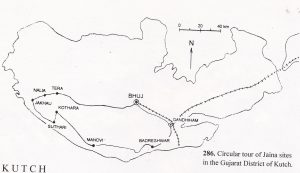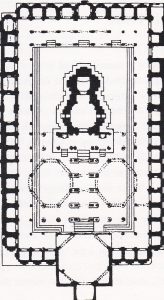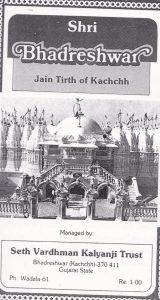Kutch

Circular tour of Jaina sites in the Gujarat District of Kutch.
“The off-the-beaten track semi-island of Kutch is a region where age-old customs have only recently been touched by modern civilization. The gates of the walled city of Bhuj – now connected by rail, road and air with the mainland used to be locked from dusk to dawn until very recent times.”
Such meagre information, cited from a publication for tourists, is about all the foreign tourist will find in his travel guide under the heading of Kutch, the western- most district of Gujarat. That means that only a few feel tempted to go and see for themselves what this remote corner of India has to offer.
For those who do go, it will be a surprise to learn that the district of Kutch, having a population of about 1.3 million, is the one with the highest density of Jainas of a the districts within the Indian Union. According to Vilas A. Sangave’s Jaina socie through the Ages (Delhi 1992: 31) the percentage of Jainas of the total population of the district of Kutch was 6.72; for India as a whole 0.48 per cent (1971 census).
The map above shows the locations of some major Jaina pilgrimage centres of Kutch. Some of the sites have a long Jaina history; but the present temples date, with a few exceptions, from the nineteenth and twentieth century. The temple of Bhad- reshwar, situated close to the sea, is such an exception. It was built or rebuilt in the middle of the thirteenth century by a so-called ‘merchant prince’ by the name of Sheth Jagdusha who was a great philanthropist.
Since that time nine major renovations have been carried out in the process of which the fifty-two devaculikas have been added, yet the plan of the main shrine has remained unchanged (ill. 288). Mandavi, the main port of Kutch, has seven Jaina temples as well as some libraries containing valuable manuscripts. The Suthari Parshvanatha temple, set in
the heart of Suthari town, the next centre of the pilgrimage circuit, is an imposing
two-storeyed building richly embellished both inside and out. Devi Padmavati is one of the divinities worshipped in this temple.
The Jaina shrine at Kothara, occasionally described as a “skyscrapper’ temple. rises to a height of seventy-four feet (22.5 m). When approaching Jakhau, the follow- ing destination of the Kutch Jaina circuit, the visitor is taken unawares by the sight of a majestic complex of nine temples. Of the Jina images enshrined in these temples, 126 are made of stone, eighty of metal, two of quartz and one of gold.
At Jakhau the road turns east, and soon the city of Naliya comes into view where the visitor is welcomed by a three-in-one temple, a spacious building lavishly decorated with gilded carvings and mosaics made of coloured glass. A special feature of this temple, dedicated to Jina Chandraprabha, is a display of 138 siddha-chakras (saint-wheels) 132 of which are made of silver, four of other metals and two of sandalwood.

 Next comes Tera, a town with two Jaina temples. One was built in 1858: the construction of the other goes back about three hundred years. Finally there is Bhuj, the capital of Kutch, where there are three Jaina temples, all built in the nineteenth century.
Next comes Tera, a town with two Jaina temples. One was built in 1858: the construction of the other goes back about three hundred years. Finally there is Bhuj, the capital of Kutch, where there are three Jaina temples, all built in the nineteenth century.
Bhadreshwar Mahavira Temple, plan and general view. A booklet containing detailed information is available at the office. For pilgrims accommodation is provided.
